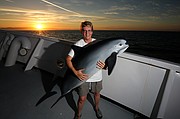Flathead native on front line of saving porpoise
There are fewer than 30 of the world’s smallest porpoise left in the Gulf of California. As the vaquita, a small, shy marine mammal with cartoon-like facial features, slips ever closer to extinction, Flathead Valley native Barbara Taylor is hoping for a miracle.
Taylor, a 1973 Flathead High School graduate, has been researching marine mammals for more than three decades and leads the marine mammal genetics program for the National Oceanic and Atmospheric Administration at the Southwest Fisheries Science Center in La Jolla, California. She’s been working with vaquitas for 25 years.
Her work has ramped up in recent years as the vaquita has begun teetering on the brink of disappearing forever, a casualty of an insatiable demand in China for totoaba, an endangered fish that shares its Gulf habitat with the vaquita. The totoaba’s swim bladder is dried and smuggled to China, where people pay thousands for the delicacy.
Poachers have killed off about 90 percent of the vaquita population in the last six years, according to an acoustic monitoring program within a climate change institute that’s part of the Mexican government. The vaquitas perish because they get caught in the gillnets.
“Sadly the vaquita [population] has kept declining because of so much illegal fishing,” said Taylor, who is vacationing on Flathead Lake during July. “It’s the last gasp for vaquitas.”
On June 30 a permanent ban of gillnets in the Gulf area began, the result of an agreement Taylor had a hand in facilitating. She met June 7 with Mexican President Enrique Pena Nieto, multibillionaire telecom magnate Carlos Slim and American movie star Leonardo DiCaprio in Mexico City, where an agreement was struck to make permanent an earlier temporary ban of gillnets.
The agreement will be backed by Slim and DiCaprio’s foundations, which are helping to fund non-gillnet fishing options to offset the economic impact of the ban.
“Mexico understands its responsibility as one of the countries with greatest biodiversity,” Pena Nieto said in an Associated Press article. “That is why we have implemented an historic effort to avoid the extinction of a unique species in the world and also to protect important ecosystems.”
Taylor, who specializes in estimating risk of extinction and has worked with some of the most endangered species, said meeting with the high-profile entourage in Mexico was productive, and also kind of exciting. Pena Nieto gave them a tour of his private gardens, “and when we went to the president’s house his six daughters were there with their Leonardo DiCaprio posters for him to sign,” she said with a laugh.
Taylor also added she was grateful for her high-school speech classes at Flathead when she was called upon to deliver some off-the-cuff narratives during the crucial meeting in Mexico.
The gillnet ban by itself won’t save the vaquita, so there’s a Hail Mary in the works.
In October, Taylor will be involved with an extraordinary recovery effort as 40 scientists with the Vaquita Conservation, Protection and Recovery group catch as many of the elusive tiny porpoises as they can and hold them in hope of restoring the population.
There have been success stories of bringing species back from the edge of extinction, Taylor said. The California condor population, which had dwindled to eight, now number 200 in the wild. Even so, it’s a long shot with the vaquita.
“It will be amazing if we’re successful,” she added.
Taylor said her love of nature comes from growing up in the Flathead Valley. It was a trip to Finland as an exchange student, though, that spurred her interest in marine life. Her Finnish family owned 300 tiny islands off the coast of Finland, and Taylor was able to spend time on those islands.
“I liked the marine world,” she said.
After that stint in Finland, Taylor got her undergraduate degree from Evergreen State College in Olympia, Washington, and won a grant to study harbor seals. She spent the next decade in Alaska, where she lived on sea ice for a year.
Taylor has been doing field research with marine mammals since 1978 and earned her Ph.D. from the University of California, San Diego.
Every summer she returns to the Flathead to spend time with her mother, Viola Taylor, who lives on Flathead Lake at Rollins. Taylor’s husband, Jay Barlow, is a marine mammal scientist who works with marine mammal acoustics.
“Testing his equipment in Flathead Lake is awesome because there’s no noise [from ships and big boats], and he can calibrate his instruments,” she said.
Features editor Lynnette Hintze may be reached at 758-4421 or lhintze@dailyinterlake.com.





